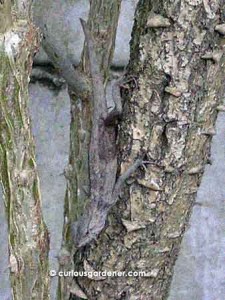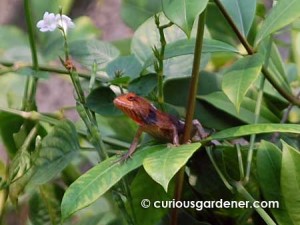
Female Oriental garden lizard climbing up a roselle bush. Notice what long, skinny digits they have? They're quite elegant looking!
I went to take a look at the clusters of fruits on my biggest roselle plant one morning, and was startled when something moved rapidly up the main stem of the plant. It turned out to be one of the several Oriental garden lizards that reside around the garden.
This little reptile is one that we’ve mistakenly been calling a chameleon. In fact, even the green garden lizard that was more common over 30 years ago was referred to as a chameleon because it could change colour to a certain extent – but was not technically a true chameleon either.
Our current residents, the Calotes versicolor or Changeable Lizards, can change colour a little. They normally range between shades of brown and gray, that I’ve seen myself, blending in with tree trunks in particular – but not perfectly so. Males, however, can radically change the colour of their heads and shoulders to shades of orange-red when they feel threatened (by camera-bearing humans :P) or when they want to woo a female lizard. They also bob their heads up and down and look like they’re doing push-ups! I guess the message to their possible partner is, Look at me! While to humans and other predators, it’s Back off, buddy!
Both males and females have pale underbellies and a spiky “mane” running down from the back of the head to somewhere along the spine.
I’m not sure exactly where they breed, but we do spot the occasional baby in the bushier shrubs – and since there appear to be a number of them, I guess they like it here!
These lizards reportedly eat insects and small vertebrates. I can vouch for the insects, because I observed one of the lizards leave the safe haven of a shrub on a rainy day to splash through a rain puddle in pursuit of a beetle swimming on the water’s surface. The beetle was caught and carried back to the shrubbery where I assume it was eaten. Gollum.

This Oriental garden lizard must be pretty old. It just looks gnarly and faded, and is missing part of its tail! However, it blends in well with the Peacock tree trunk, doesn't it?
And don’t assume that these garden lizards are nice and cute like house geckos. They happen to have rows of sharp, pointy teeth that are probably very useful in catching and consuming their prey. I know this because I’ve come across a few dead lizards in the garden, and the teeth were very visible as the bodies decomposed. I’m actually quite happy that these garden lizards don’t grow too big, because they’re quite fierce looking, and they happen to be related to iguanas!
Oriental garden lizards are are also very territorial. Different parts of the garden seem to be staked out by different lizards. Yes, there are usually enough distinguishing features that allow us to identify the lizards – and they are faithful to their chosen territories. There’s the one that patrols the low garden wall – a male, because it turns red and does push-ups – then there’s the gnarly, mean looking one on the pink peacock tree. There’s a female at the back trellis area, and a juvenile one around the sweet potato patch.
Okay, maybe they’re cute, after all. We see them in all sorts of places – clinging to plant stems, running through higher plants, sunbathing on all kinds of things in the garden… They also run fast. I recall one of our previous dogs literally chasing one of these lizards round and round a bush, and being unable to catch it. As far as I’m concerned, they’re a part of our garden ecology and I’m glad to have them around.


Eh, the lizards are so adorable! They’re such a stark contrast to the house geckos living in my garden, but just as cute. Lol.
They’re such a stark contrast to the house geckos living in my garden, but just as cute. Lol.
Yup, they’re cute – especially when they’re running away with their tails in the air! We startle each other fairly often as, like I said, they’re everywhere, and they get nervous if you get too close.